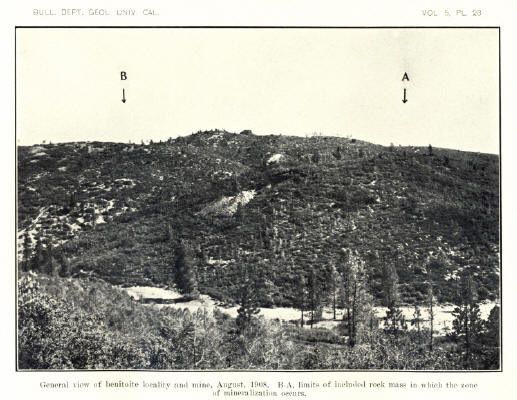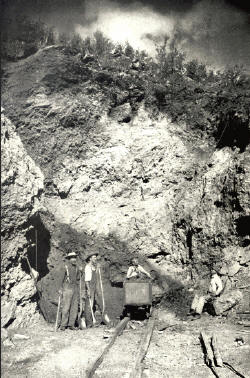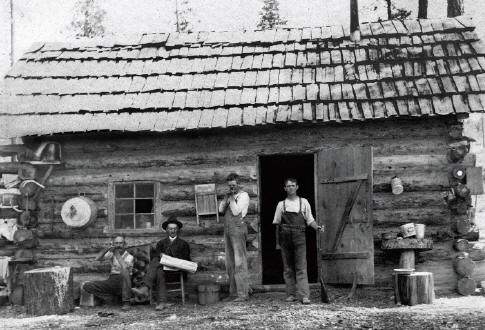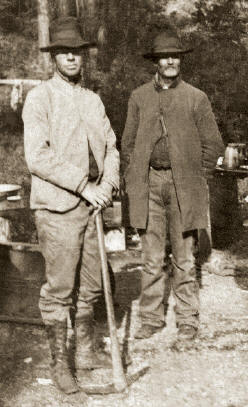Benitoite – almost every mineralcollector desires to have a specimenof this unique blue mineral. Aside froma few small nearby deposits, only theBenitoite Gem mine has commerciallyproduced gem quality benitoite andspecimens of stunning beauty. Since itsdiscovery in 1907, literally tens of thousandsof benitoite and neptunite specimenshave been produced. It is a slowand involved process to remove theencasing natrolite with various chemicalsbut the effort is well worth it to uncoverthe mineral heritage from oneof the most unique mineral depositsin the world. The State of California recognizedthe significance of this distinctivemineral by declaring it to be the Official State Gemstone of California.
OnOctober 1, 1985 in Sacramento, California,the State legislature passed AssemblyBill No. 2357. The text was simple,but it was everything that everyone whoknew anything about benitoite had everhoped for. Section 425.3 is added to theGovernment code to read: Benitoite isthe official state gemstone of California.

Benitoite on natrolite, 3.7 cm high, Benitoite Gem mine. A. Seibel specimen.
LOCATION
The Benitoite Gem mine, formerlyknown as the Dallas Gem mine, is situatednear the southern tip of San BenitoCounty about 30 km to the north andwest of Coalinga, California. The town ofKing City lies about 45 km to the west ofthe mine. In a broader sense the mine lies about half way between San Franciscoand Los Angeles. The stereotype ofCalifornia usually involves visions ofendless beaches, and lots of people. Thissection of California however, is consideredremote by just about any standardimaginable. Few roads and no amenitiesthat most people are used to can befound within 30 km in any direction. Theonly way to get near the mine, other than by a privately owned chip sealed road, isvia a bumpy dirt road with several unimprovedstream crossings. Travel in thewinter time is nearly impossible due tosnow and very slick, muddy roads. Themine is positioned just upslope of theSan Benito River at an altitude of 1,380meters.
The coastal mountains between SanFrancisco and Los Angeles are expansiveand for the most part even today,empty of any human development otherthan ranches and a few small towns androads which transect them. Imagine thedifficulty in accessing this region in 1907,the year benitoite was discovered, whenthere were no roads and the only meansof moving through the area was on foot.
The vegetation in the area consists ofvery thick chaparral that is seeminglyimpossible to walk through yet that wasthe task set in front of James Couch ashe left Coalinga to prospect the area in southern San Benito County for newmercury deposits in early February,1907.

Plate from Louderback paper published in 1909. Photo of mine area one year after discovery.Arrows shows limit of mineralization.
HISTORY OF THE DEPOSIT
James Marshall Couch had beengrubstaked by Roderick Dallas andThomas Sanders with $50 worth of suppliesand a horse. It was mid-winter when Couch set out, so there was likelysome cold weather to contend with ashe made his way into the headwatersof the San Benito River looking for traces of minerals eroding out of the adjacenthills.
It is reported in several sourcesthat he found a forested glade along thesmall river and made camp after havingbeen prospecting for several weeks. Thisoffered him a flat place with grass feedfor his horse, and plenty of firewood forhimself to keep warm during the longcold nights.

Mining in the Dallas Gem mine in 1908. Photo was published in Louderback’s paper, 1909.
Accounts of the discovery reportthat on February 22, 1907 Couch climbedthe hill across from his camp to lookfor possible outcrops to investigate.
On his way up the slope he stumbledupon a small area literally littered withmyriads of small dark blue crystals.
He initially suspected the crystals tobe diamonds or sapphires owing tothe blue color and set about to collecta small hoard then raced back toCoalinga to announce his discovery.
Itis possible that the Native Americanswho inhabited this region may haveseen this deposit at some point in thedistant past on a hunting trip but asfar as Couch could tell no one had everbeen to this spot before. Imagine thisoutcrop weathering for millennia withno one knowing of its existence andthen being the first person to have everseen this rich blue mineral layingin abundance on the ground! Creditfor the discovery was taken by otherpeople, primarily Roderick Dallas andanother fellow by the name of LelandHawkins, but sifting through the historical records suggests that Couch was thesole discoverer of the deposit.

Map of USA with location of the Benitoite Gem mine, and inset showing detail of the mine area.
It did not take long for the area tobe legally claimed and mining to commence.
The claim was given the nameof Dallas Gem mine in recognition of thefinancial backing provided by Dallasfor the operation. Still, none of the charactersinvolved knew what it was thatthey were mining. Speculation centeredon the crystals being sapphire or spinelor even some form of volcanic glass.
Later in 1907 a small group of specimensfound their way to Dr. GeorgeLouderback who was professor ofmineralogy at the University of California,Berkeley. Louderback quickly recognizedthat this blue mineral was newto science. He also thought that theaccompanying dark black mineral associatedwith the blue mineral, was alsonew to science. He set out to publisha preliminary note in July 1907 onthe new species and tentatively calledthe blue mineral benitoite named afterSan Benito County and the San BenitoRiver. He suggested that the blackmineral be named carlosite after thenearby San Carlos Peak. Later in 1907Louderback determined that carlositewas in fact neptunite – a mineral whichhad been discovered in 1893 in Greenland.

Cabin at Dallas Gem mine built during the summer 1907 for $35. Mine team with riffles and pistols. James Couch is second from the left. Photo courtesy of Collector’s Edge.
After securing more specimens andhaving a chance to actually go to themine site Louderback commenced to formallydescribe the new mineral benitoite.
Many people consider this one ofthe finest descriptions of a new mineralspecies ever written. It was published in1909 with the chemical analyses beingcompleted by Walter Blasedale. All of thehand-colored copies were quickly dispersed to universities and mineralogistsaround the globe.

Photo taken in the Dallas Gem mine in 1907 showing Roderic Dallas (left), first owner of the mine, and James Couch (right), discoverer of the deposit. Photo courtesy of Collector’s Edge.
Initial recovery of benitoite consistedof breaking open the encasing natroliteby sledge to find the gem nodules.








 YueGongAnBei 44051102000467
YueGongAnBei 44051102000467


 |
|